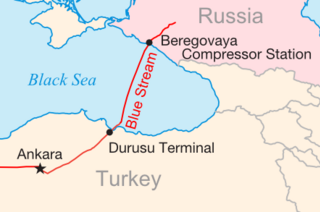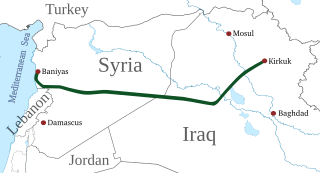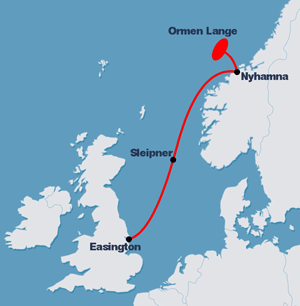
A pipeline is a system of pipes for long-distance transportation of a liquid or gas, typically to a market area for consumption. The latest data from 2014 gives a total of slightly less than 2,175,000 miles (3,500,000 km) of pipeline in 120 countries around the world. The United States had 65%, Russia had 8%, and Canada had 3%, thus 76% of all pipeline were in these three countries.
Trenchless technology is a type of subsurface construction work that requires few trenches or no continuous trenches. It is a rapidly growing sector of the construction and civil engineering industry. It can be defined as "a family of methods, materials, and equipment capable of being used for the installation of new or replacement or rehabilitation of existing underground infrastructure with minimal disruption to surface traffic, business, and other activities."

In pipeline transportation, pigging is the practice of using pipeline inspection gauges or gadgets, devices generally referred to as pigs or scrapers, to perform various maintenance operations. This is done without stopping the flow of the product in the pipeline.
Pipeline video inspection is a form of telepresence used to visually inspect the interiors of pipelines, plumbing systems, and storm drains. A common application is for a plumber to determine the condition of small diameter sewer lines and household connection drain pipes.

Blue Stream is a major trans-Black Sea gas pipeline that carries natural gas to Turkey from Russia. The pipeline has been constructed by the Blue Stream Pipeline B.V., the Netherlands based joint venture of Russian Gazprom and Italian Eni. The Blue Stream Pipeline B.V. is an owner of the subsea section of pipeline, including Beregovaya compressor station, while Gazprom owns and operates the Russian land section of the pipeline and the Turkish land section is owned and operated by the Turkish energy company BOTAŞ. According to Gazprom the pipeline was built with the intent of diversifying Russian gas delivery routes to Turkey and avoiding third countries.

Nord Stream is a pair of offshore natural gas pipelines in Europe that run under the Baltic Sea from Russia to Germany. It comprises the Nord Stream 1 (NS1) pipeline running from Vyborg in northwestern Russia, near Finland, and the Nord Stream 2 (NS2) pipeline running from Ust-Luga in northwestern Russia near Estonia. Both pipelines run to Lubmin in the northeastern German state of Mecklenburg-Vorpommern. Each pipeline comprises two pipes, denoted A and B; each of the four pipes is approximately 1,200 kilometres (750 mi) long and with approximate diameters of 1,220 millimetres (48 in). The combined capacity of the four pipes is 110 billion cubic metres per annum of natural gas.
The Alaska gas pipeline is a joint project of TransCanada Corp. and ExxonMobil Corp. to develop a natural gas pipeline under the AGIA, a.k.a. the Alaska Gas Inducement Act, adopted by Alaska Legislature in 2007. The project originally proposed two options during its open season offering over a three-month period from April 30 to July 30, 2010. An 'open season' in layman's terms is when a company conducts a non-binding show of interest or poll in the marketplace, they ask potential customers "if we build it, will you come?".

A cured-in-place pipe (CIPP) is a trenchless rehabilitation method used to repair existing pipelines. It is a jointless, seamless pipe lining within an existing pipe. As one of the most widely used rehabilitation methods, CIPP has applications in sewer, water, gas, chemical and district heating pipelines ranging in diameter from 0.1 to 2.8 meters.

The Kirkuk–Baniyas pipeline is a currently defunct crude oil pipeline from the Kirkuk oil field in Iraq to the Syrian port of Baniyas. The pipeline went into operation in April 1952 and was formally opened in November.

Hydrogen pipeline transport is a transportation of hydrogen through a pipe as part of the hydrogen infrastructure.

Plastic pipe is a tubular section, or hollow cylinder, made of plastic. It is usually, but not necessarily, of circular cross-section, used mainly to convey substances which can flow—liquids and gases (fluids), slurries, powders and masses of small solids. It can also be used for structural applications; hollow pipes are far stiffer per unit weight than solid members.

The Baku–Supsa Pipeline is an 833-kilometre (518 mi) long oil pipeline, which runs from the Sangachal Terminal near Baku to the Supsa terminal in Georgia. It transports oil from the Azeri-Chirag-Guneshli field. The pipeline is operated by BP.

Power of Siberia is a Gazprom-operated pipeline in Eastern Siberia that transports natural gas from Yakutia to Primorsky Krai and China. It is a part of the eastern gas route from Siberia to China. The proposed western gas route to China is known as Power of Siberia 2.
Sliplining is a technique for repairing leaks or restoring structural stability to an existing pipeline. It involves installing a smaller, "carrier pipe" into a larger "host pipe", grouting the annular space between the two pipes, and sealing the ends. Sliplining has been used since the 1940s.

Ductile iron pipe is pipe made of ductile cast iron commonly used for potable water transmission and distribution. This type of pipe is a direct development of earlier cast iron pipe, which it has superseded.
Cast iron pipe is pipe made predominantly from gray cast iron. It was historically used as a pressure pipe for transmission of water, gas and sewage, and as a water drainage pipe during the 17th, 18th, 19th and 20th centuries.
Michels Corporation is a family owned and operated energy and infrastructure construction company. Headquartered in Brownsville, WI, where it was established in 1959, Michels is one of the largest contractors in North America. It performs work throughout the world.

The Kalamazoo River oil spill occurred in July 2010 when a pipeline operated by Enbridge burst and flowed into Talmadge Creek, a tributary of the Kalamazoo River near Marshall, Michigan. A 6-foot (1.8 m) break in the pipeline resulted in one of the largest inland oil spills in U.S. history. The pipeline carries diluted bitumen (dilbit), a heavy crude oil from Canada's Athabasca oil sands to the United States. Cleanup took five years. Following the spill, the volatile hydrocarbon diluents evaporated, leaving the heavier bitumen to sink in the water column. Thirty-five miles (56 km) of the Kalamazoo River were closed for clean-up until June 2012, when portions of the river were re-opened. On March 14, 2013, the Environmental Protection Agency (EPA) ordered Enbridge to return to dredge portions of the river to remove submerged oil and oil-contaminated sediment.

A submarine pipeline is a pipeline that is laid on the seabed or below it inside a trench. In some cases, the pipeline is mostly on-land but in places it crosses water expanses, such as small seas, straits and rivers. Submarine pipelines are used primarily to carry oil or gas, but transportation of water is also important. A distinction is sometimes made between a flowline and a pipeline. The former is an intrafield pipeline, in the sense that it is used to connect subsea wellheads, manifolds and the platform within a particular development field. The latter, sometimes referred to as an export pipeline, is used to bring the resource to shore. Sizeable pipeline construction projects need to take into account many factors, such as the offshore ecology, geohazards and environmental loading – they are often undertaken by multidisciplinary, international teams.

A water distribution system is a part of water supply network with components that carry potable water from a centralized treatment plant or wells to consumers to satisfy residential, commercial, industrial and fire fighting requirements.













